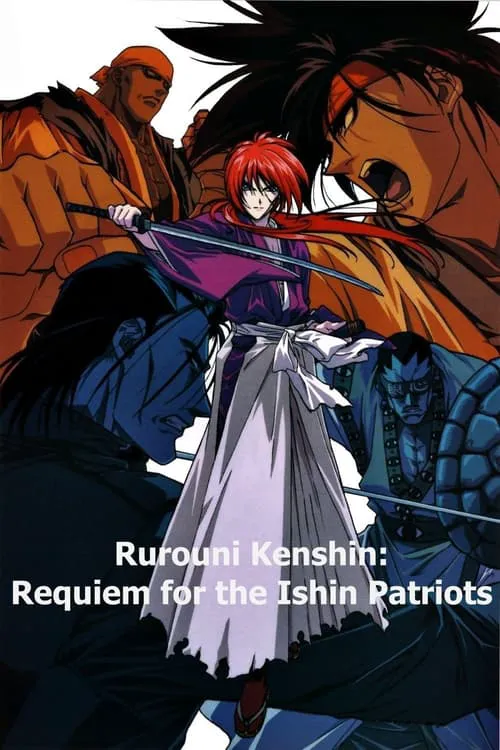Rurouni Kenshin: Requiem for the Ishin Patriots

Plot
Rurouni Kenshin: Requiem for the Ishin Patriots The year is 1878, nearly two decades after the Boshin War ended the Tokugawa Shogunate's grasp on Japan. It was a time of great change, but not all of the nation's people felt that progress was just. Shigure Takimi, a young man haunted by the ghosts of the past, had lost everything in the name of fighting for his ideals. He had been a passionate advocate for the overthrow of the Tokugawa regime, but the end result had been far more bitter than sweet. As Shigure reflected on the war and its aftermath, he realized that the victors had often turned out to be the perpetrators of their own brand of tyranny. The ideals of freedom and prosperity that had driven him and so many others to take up arms against the Shogunate had been distorted and used as a justification for their own power-hungry ambitions. With a deep and abiding rage burning within him, Shigure sought out a group of like-minded individuals who shared his desire for revenge against those who had betrayed them. Together, they formed an unlikely band of rebels who saw themselves as champions of justice in a world gone mad. Their target was Rurouni Kenshin, the once-notorious assassin turned wandering swordsman. Kenshin, with his signature reverse-bladed sword and kind heart, had become a symbol of hope in the post-war era, and Shigure saw him as the ultimate obstacle to their plans. Unbeknownst to Kenshin, however, Shigure had a personal connection to his past that made their confrontation all the more inevitable. It was this connection, as well as the growing ferocity of his crusade, that would eventually lead Shigure to confront Kenshin and challenge his ideals. The movie opens with a striking scene of Shigure, clad in his dark samurai armor, walking through a desolate mountain path. The silence is broken only by the sound of the wind rustling through the trees as Shigure's face is lit by the fading light of day. His thoughts are with his comrades and friends who had fallen during the war, all of whom had died for a cause that had ultimately been betrayed. As the sun dips below the horizon, the scene shifts to a group of rebels, led by Shigure, huddled around a campfire. They are planning their final battle against Kenshin, determined to right the perceived injustices of the post-war era. Shigure's impassioned plea to his comrades, in which he likens Kenshin to a fox that has donned the cloak of a hero in order to manipulate the gullible, marks a turning point in the movie. The tension builds throughout the following scenes, which intercut between the preparations of the rebels and the more relaxed atmosphere of the Kyoto's Kamishibai Street, where Kenshin is enjoying a peaceful life as a wandering swordsman in a traveling troupe of street performers. Shigure's search for Kenshin eventually leads him to the very heart of Kyoto, where a series of increasingly intense showdowns ensue between the rebels and Kenshin's friends. From the moment Shigure and his cohorts lay eyes on the legendary Rurouni, it becomes clear that their desire for revenge goes far beyond simple politics. As the action unfolds, it is revealed that Kenshin's past has left deep scars, not only on him, but on those who have come into contact with him. Shigure, it seems, has a connection to Kenshin that goes far beyond a simple vendetta. One of the most striking aspects of the movie is the development of Shigure's backstory, which slowly comes into focus as the story progresses. It is the memories of his loved ones and the pain of their loss that drives Shigure's unyielding quest for revenge. In a series of dramatic flashbacks, we are taken back to a time when Shigure and Kenshin were at the forefront of the fight against the Tokugawa Shogunate. Kenshin, in his younger days, was indeed a brutal assassin for the regime, and it was Kenshin's subsequent rejection of his true role that had ultimately led Shigure's family and friends to be butchered in the crossfire. When Shigure finally confronts Kenshin, their battle is not merely a clash of ideologies or a test of strength. It is, rather, a deeply personal confrontation, one that will determine the very course of their lives. As their duel reaches its climax, we realize that Kenshin's actions throughout the battle have been motivated less by a desire to fight or protect, and more by a desire to protect those he cares about. In a final, poignant moment, Kenshin takes Shigure aside and confronts him directly about his quest for vengeance. With tears in his eyes, Kenshin implores Shigure to see the truth of his situation, to understand that the past is forever lost, and that their hatred for each other will never be quenched if they continue on this path. In that moment, Shigure's resolve begins to break, and the true nature of their conflict comes into focus. They are two men who have been trapped by their own memories, each unable to shake off the trauma of the past. As the movie draws to a close, the scene shifts back to the present, and Kenshin's resolve has changed. Though he is prepared to fight Shigure and his band of rebels, the heartache and understanding that they have finally discovered for each other has changed the nature of their battle. In the end, Kenshin will not kill Shigure or the other rebels, but will instead try to persuade them to lay down their arms, hoping that they might find a similar sense of redemption and hope for the future that he has discovered. In the end, it is a movie about loss, grief, and redemption, as well as the transformative power of empathy.
Reviews
Recommendations




